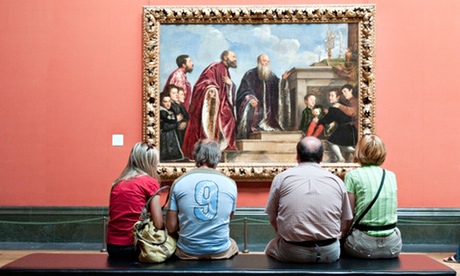
“Hour by hour, and week by week, the thing upon the canvas was growing old …No! The thing is impossible.” In Oscar Wilde’s The Picture of Dorian Gray, the painter Basil Hallward is dismayed by the catastrophic changes that have wrecked his great portrait. In this eloquent study, the art historian Paul Taylor demonstrates that all artworks undergo countless metamorphoses. Some of them occur over centuries, and all too many in seconds. He shows us why foliage in paintings so often looks brown or blue; why a face has cracked, pocked, blurred or paled in a particular way; why so many artworks are fragments; and why pictures in the National Gallery tend to be brighter and more pristine than those in Italian museums.
Taylor starts by noting how often art historians and art lovers are misled by their ignorance of what we might term the medical history of the works they are looking at. “Literary historians are occasionally faced with corrupt texts; art historians face corrupt paintings every day of their working lives”, often without being aware of it. Many pictures have been repainted, and here Taylor uses a personal example. He recently asked to see a frequently reproduced painting of a pointing angel from Leonardo’s studio. He was told by the museum where it is housed in Basel that since 1989 the angel had been a John the Baptist, holding a cross. Restoration had revealed that the cross had been painted out, almost certainly at the behest of the man who gave it to the museum in 1942: he wanted it to become Leonardo’s angel of the annunciation, as described by the painter and historian Giorgio Vasari.
Not all alterations are so dramatic. One of the most common changes is a general darkening of the picture. This is sometimes romantically approved of because “time the painter” seems to mellow garish colours and harmonise them (not least with smoke stained walls). But Taylor gives fascinating examples of big art historical theories being built on mistaken understandings of the picture’s condition. So the gloomy darkness that TJ Clark theorised about in Poussin’s Landscape With a Man Killed By a Snake (National Gallery) is largely the product of chemical changes in the paint and especially of relining: details that are no longer clearly visible appear in an early print.
Relining – attaching a new canvas to the back of a damaged painting – was routinely performed between around 1670 and 1970. Taylor has an anecdote about a modern conservator who relined a perfectly good picture as a preemptive strike to “preserve” its perfection. He notes how readily art historians and critics attack the cleaning policies of museums, “but no art historian has ever started a lining controversy”. Relining was done because over time canvases can sag, causing the paint to flake off. The painting was taken off the wooden “stretcher” to which it had been nailed, and placed face down on a muslin-covered flat surface. Glue was spread on the back and a fresh canvas placed on top of it. The glue needed to melt so that it could seep through the original canvas and stick the flaking paint back on to the picture’s ground layer: this was done by ironing. Unfortunately, with no temperature controls, the iron was often too hot, causing the paint to bubble (as in Titian’s huge The Vendramin Family in the National Gallery), crack, crumble and burn, usually turning white skin the colour of milky coffee.
An example of a Dorian Gray-style disaster is Giovanni Battista Moroni’s Portrait of Leonardo Salvagno, also in the National Gallery. It is sadly crushed, singed, discoloured and pockmarked. The good news is that the gallery’s other Moroni portraits are in better condition. Today, conservators glue individual flakes of paint, pressing them down with a spatula.
A fascinating chapter called “Losses” explores the many ways in which artworks become fragments or are destroyed completely, and the responses of curators and conservators. Taylor estimates that only around 5% of Dutch 17th and 18th-century art survives, and the losses for earlier periods are far higher. Changing taste accounts for more than natural disasters such as fires: Pope Julius II destroyed frescoes by Piero della Francesca and Pietro Perugino to make way for new ones by Raphael, and some of the lime used to make the wall plaster probably came from “recycled” ancient marbles.
The surfaces of many pictures have been damaged by overcleaning, and Taylor’s book concludes with a damning assessment of the ceiling of the Sistine chapel, cleaned 30 years ago. The restorers believed Michelangelo painted the fresco without any retouching when the plaster was dry (a procedure known as secco). They argued that any additions were the work of later restorers, and removed them all with an alkaline solvent. With the help of an early reproduction, Taylor shows that they removed draperies, folds and shadows that were present in the 16th century. The sad fact is that if they had tried to preserve the secco, and used less invasive cleaners like saliva, they might still be toiling away today. Time isn’t just a painter; time is money.
• James Hall is the author of The Self Portrait: A Cultural History. To order Condition for £24 (RRP £30) go to bookshop.theguardian.com or call 0330 333 6846. Free UK p&p over £10, online orders only. Phone orders min p&p of £1.99.

